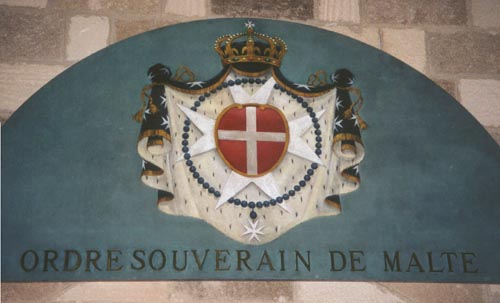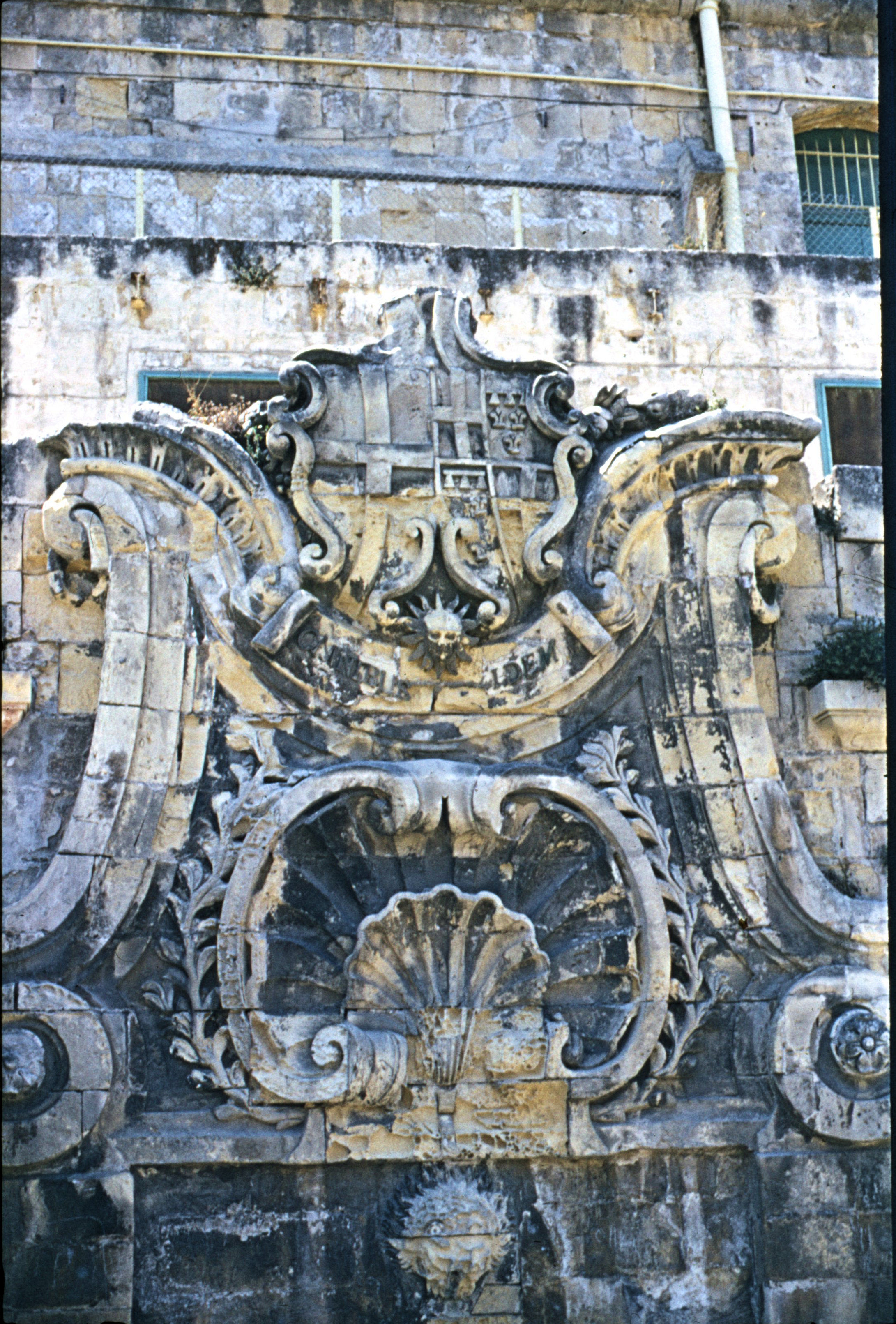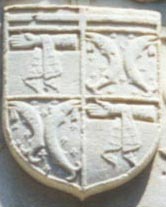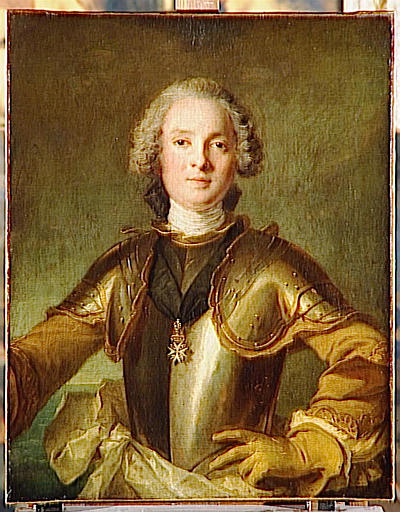
Modern arms of the Order, from a panel in the palace of the Grand Masters, Rhodes.
This page is mainly interested in the heraldic aspects of the Order. The historical overview provided here is meant as a framework for a better understanding of the heraldry. For more information see the other resources on the Web.
This section provides a brief historical sketch and some information on the current state of the Order. It owes a lot to H.J.A. Sire: The Knights of Malta, New Haven, 1994; Yale University Press. I have also consulted Berthold Waldstein-Wartenberg: Rechtsgeschichte des Malteserordens, Wien, 1969; Verlag Herold.
Please see Guy Sainty's page as well.
The origin of the Order lies in a hospice for pilgrims created next to the Benedictine Abbey of St-Mary of the Latins in Jerusalem. The abbey was founded ca. 1050 by Amalfitan merchants, and the hospice ca. 1080 by Brother Gerard, and dedicated to Saint John the Baptist. Its servants formed a lay fraternity under the Augustinian rule. With the conquest of Jerusalem in 1099 and the establishment of the Crusader states throughout Palestine, the numbers of pilgrims increased, but the semi-permanent state of war in the area exposed them to greater dangers. A papal bull of 1113 recognized the Hospitallers of Saint-John as a monastic order, and soon after, perhaps under the influence of the Templars (founded in Jerusalem in 1120) the Hospitallers turned into armed guards, and soon into fighting monks, participating alongside the Crusaders and holding fortresses as well as hospices across the Holy Land. This militarization probably occurred in the 1130s. The structure of the order is unclear in the 12th century, as there seemed to have been professed fratres alongside lay confratres, fighting knights in large numbers. Many of them perished in the battles which led to the fall of Jerusalem in 1189, and the Order fell back to Margat in the county of Tripoli, and a few years later to Acre.
In 1206 the first Statutes of the Order were issued, which divided the order between priests or chaplains, knights and sergeants (fighting men who were commoners). The Mastership (a title copied from the Templars around 1140) was restricted to knights in 1262.
After the fall of Acre in 1291 the Order fell back to Cyprus, then managed to conquer Rhodes ca. 1310 and inherit the Levantine estates of the Templars who had been abolished in 1312. They stayed in Rhodes until forced out by the Turks in 1522, at which time the Emperor and Spanish king Charles V gave them the island of Malta (1530) where they established themselves again.
The name of the Order, until the 18th century, was Holy Order (or Religion) of [the Hospital of] Saint-John of Jerusalem, modified in the late 15th c. by the addition of and of the Sepulchre of Christ to reflect the incorporation in 1489 of the Order of the Canons of the Holy Sepulchre (distinct from the Knights of the Holy Sepulchre).
The Grand-Master was made Prince of the Holy German Empire in 1607, a title which carried with it the rank of Serene Highness; in 1630, the Pope granted the Grand-Master the rank of Eminence, similar to that of the cardinals. In 1741, the Grand-Master combined the two into Most Eminent Highness, a style which is still used today.
In 1301, the Order had organized itself in seven Langues: Provence, Auvergne, France, Spain, Italy, England and Germany, with a Pilier at the head of each, holding one of the top six offices of the order: Grand Commander, Marshal, Hospitaller, Drapier, Admiral, Turcopolier (Germany did not have an office; the office of Treasurer was never ascribed to a Langue).
The Langues corresponded to regional groupings of priories, the priories themselves groupings of commanderies. These consisted in the large number of estates which had been given over time to the Order (commendatoria meaning trust, and commendator meaning trustee; the words were later corrupted into commandery and commander). The commanderies could simply be estates, or houses where lay people were allowed to live and share some of the spiritual life of the Order (the corrodaries), or men and women who did not meet the nobiliary requirements (the confratres or donats), or where novitiates prepared for their vows. Some houses were convents of monks and nuns. The Langues were expected to send a set number of Knights to the main Convent in Rhodes (and later Malta).
The requirements to be a knight were initially to be of knightly family, but over time they became more stringent: in the 1350s nobility of both parents, in 1428 nobility of four generations on the father's side, in 1550 nobility of four quarters (all grandparents). The Langues each had their own requirements which could be stiffer: the French called for 8 quarters, the Italians 200 years in all four lines, the Germans 16 quarters, etc. In the 17th century nobility of robe or office was excluded.
Knights entered the novitiate, took simple vows after 1 year and solemn vows after the age of 21. Professed members (be they knights, chaplains or sergeants) were called "of Justice". The sergeants wore the "half-cross". Individuals who did not meet the nobiliary requirements but had otherwise distinguished themselves could be made Knights of Grace (the painter Caravaggio in 1608), while Knights of Justice who had to renounce their vows and marry for family obligations could become Knights of Devotion. The Donats were also entitled to the half-cross. In the 1630s there were about 1700 knights in the Order.
The French Revolution marked the beginning of a new era for the order. In 1792 the estates of the order within France were confiscated. This confiscation was extended to their estates in other parts of Europe as French conquests advanced. In 1798, Bonaparte captured Malta with outrageous ease and expelled the Order. Some knights who had found refuge in St. Petersburg proclaimed the married, non-Catholic and non-knight Czar Paul I as their Grand-Master, and most surviving priories (except in Spain) acknowledged the election (1798) against the Pope's wishes. The Czar even created an Orthodox priory in 1799, and bestowed membership most liberally. He died assassinated in 1801. His successor Alexander I declined to assume the grand-mastership and instead turned to the Pope to name a new grand-master. Pius VII appointed Giovanni Tommasi in 1803, and the Grand-Master reformed the Convent (the heart of the order) in Messina. On his death in 1805, a new Grand Master was elected but the Pope refused to recognize him, and the Mastership fell in a 70-year hiatus, the Order being governed instead by elected lieutenants. In the next years, various attempts at reestablishing territorial sovereignty failed. In 1814, contrary to expectations, Malta remained in British hands and the order settled in Catania. Various plans to settle in Elba or Greece floundered. Relations between the Lieutenancy in Messina (and from 1826 in Ferrara) and the knights in France and Spain were severed. Remnants of the Order were finally offered a home by the Pope in the old Maltese embassy in Rome in 1831. Starting in the 1860s a number of national associations sprang up in various European countries, replacing the old system of Langues, and in 1879 the Pope appointed the existing Lieutenant as Grand Master. Good relations were maintained with the Italian government which accorded extra-territoriality to the Palazzo Malta, and finally signed a treaty modelled on the Lateran Treaty in 1930.
It was in the period between 1798 and 1961 that the Order thus acquired its present character. In particular, forms of membership which did not require solemn vows or even proofs of nobility were created or vastly extended: knights of honor and devotion, conventual chaplains ad honorem, knights of magistral grace and donats. Among professed knights, a series of three ranks was created: knight, commander, and bailli-grand-cross. In the category of knights of honor and devotion, a rank of honorary bailli-grand-cross was created, as well as a rank of grand-cross among the knights of magistral grace.
Membership grew as follows:
1880 1900 1921 1932 1949 -Professed- Knights of Justice 99 84 55 65 63 Conventual Chaplains 18 13 7 6 9 Chaplains of Obedience 43 138 37 15 6 Donats of Justice 11 16 9 4 6 -Non Professed- Knights of Honor 969 1078 1175 1563 1883 Dames of Honor 119 111 155 196 272 Knights of Magistral G. 23 37 95 444 1500 Donats 78 111 294 308 1090 Honorary chaplains 3 9 16 58 150 ----- Total 1363 1597 1843 2658 4979
The growth in Knights of Magistral Grace and Donats (the ranks which do not require nobility) is particularly striking. As a result, in 1961 the total membership stood at 7557, of which less than 1% were professed.
The present status and organization of the order dates from 1961.
(Warning: I have not yet found a clear and detailed explanation of the various categories and ranks in the Order, so the following is likely to be inaccurate.)
The Sovereign Military and Hospitaller Order of Saint-John of Jerusalem, Rhodes and Malta or Sovereign Order of Malta, whose present constitution dates from June 24, 1961, consists of three distinct entities or categories:
There are also similar ranks for chaplains:
The order also confers a decoration since 1916, the Cross of Malta pro merito melitensi for services to the Order's charitable works. This decoration has three ranks: Collar (for heads of state), Cross (including Grand-Cross, Grand-Officer, Commander, Office and Cross of Merit), and Cross pro piis meritis for members of the clergy (including Grand-Cross and Cross). The insignia of the decoration is a white cross moline with a red roundle in its center bearing a white Maltese cross.
The Order is governed by the Grand-Master and the Sovereign Council, which includes members ex officio and elected members. The Order's four oficers are the Grand-Commander, the Grand-Chancellor, the Hospitaller and the Receiver of the Common Treasury.
The Order considers itself to be an internationally recognized sovereign entity although without territorial basis. Two of its possessions, the Palazzo Malta, via Condotti, Rome and the Villa Malta, also in Rome, are given extra-territorial status by Italy since 1869. The order also owns The fortress Sant'Angelo in Malta since 1991. It mints coins, which do not circulate, but it also prints stamps accepted by 45 national post offices. The Order enjoys recognition from and has diplomatic relations with 67 countries (including Spain, Italy, Russia, Austria, Egypt, Brazil), has "legations" in 6 countries (including France, Germany, Belgium, Switzerland), and is a permanent observer at the UN since 1994.
For all its sovereignty, however, the Order is also an Order of the Roman Catholic Church, and as such recognizes the authority of the Pope over the Order's professed members in religious matters. This authority, finally clearly delineated in the 1950s, had been the source of conflicts, most notably the during 1951-62 interregnum.
The sovereignty of the order is a complex and controversial matter examined in greater detail here.
The Order's main activities are religious and charitable (hospital and medical assistance). The Order is financed through members' fees and donations, as well as charitable contributions from well-wishers; these sums are mostly collected and spent by the national associations.

The arms of the Order are Gules a cross argent. The full arms show the shield surrounded by a chaplet and placed over a cross of Malta, all within a mantle and surmounted by a closed crown. In 1776, when the (religious) order of Saint-Antoine in France was united with Malta, a double-headed eagle displayed holding in each beak a Tau was added behind the shield; the eagle had been granted to Saint-Antoine by Maximilian I. The eagle appears on 18th century coins from Malta (see a silver coin of 1790) but disappeared in the 19th century.

The arms of the Grand-Master Pinto de Fonseca (1742-73), from a gold coin. Notice the closed crown and the Baroque, asymmetric shape of the shield.
The head of the order was traditionally called Magister Hospitalis Sanctis Johannis Hierosolym (master of the hospital of Saint John of Jerusalem), although on their seals they are only called custos until they left Jerusalem in 1291. The name of the order lengthened to "Hospital of Saint John of Jerusalem and Acre", then "Jerusalem, Acre and Rhodes" after the conquest of that island in 1308. With that conquest came sovereignty, (immediately indicated by the style "by the Grace of God" for the Master) and among other rights that to coin money. The order minted coins more or less continuously until 1798 and the legends and figures reflect changing styles (see Mémoires Numismatiques de l'Ordre de Saint-Jean de Jérusalem, by Edouard-Henri Furse; Rome, 1885).
The arms of the Master first appear on the obverse of coins with Roger de Pins (ca. 1360). They appear on the obverse, which shows the grand-master wearing a cape with a cross, kneeling before a reliquary of the True Cross. The shield is behind him on the right of the coin. The reverse of the Order's gigliati coins shows a cross flory, rather similar to that on French gold coins of the time. The mention of Acre disappears under Philippe de Nalhac (1396-1421); the title of "Grand Master" first appears under his successor Antoine Fluvian ("grammastro di Rodi" in Italian on an imitation of a Venetian sequin; cf. the title given to Pierre d'Aubusson on the gate of Saint Athanasios, Rhodes: "Rhodiorum Magnus Magister"). In a letter sent in 1423 by Venice to the Grand Master to express displeasure at the minting of imitation Venetian ducats, he is styled "reverendissimus dominus Magister Rodi" (cited in Papadopoli: Le Monete di Venezia, 1912; vol. 1, p. 250).
Grand-Masters quarter their arms with those of the order ( Gules a cross argent) since Philibert de Nalhac. With Jean de La Valette the Maltese cross is first shown on the reverse of some coins. The distinctive shape of the Maltese cross seems to date from the 16th century. Miniature illustrations of Caoursin's history of the siege of 1480 show the Grand Master's cape with a cross that is not yet of the classic shape; the arms of the cross are split and the ends of the arms taper out. In 1581, a coronet was added above the arms of the grand-master: a row of pearls, later intermingled with leaves, and then (under Adrien de Wignacourt) only leaves. In 1630 the Grand-Master was given by the pope the precedence of a cardinal and the style of "Most Eminent Highness". The closed crown of sovereignty was first used in 1741. At the same time, the arms of the order itself appear in their modern form on the coins: the shield, the Maltese cross behind it, the chaplet around it and the closed crown. Since the 18th century, a princely mantle has been placed behind the arms. Two Grand Masters who were made cardinals, Pierre d'Aubusson and Hugo Loubenx de Verdala, and displayed the cardinal's hat over their arms.

See also the armory of the Grand Masters with some illustrations.

Bailliffs (or Baillis) were the heads of the Tongues and holders of the great offices of the order. Since the 15th century they bear a chief with the arms of the order. Miniatures in Caoursin's manuscript show the Baillis in session around the Grand Master, each holding a string of beads with a fiocco at the end; also, the tombstone of the French Bailli Montmirel in the Archaeological Museum, Rhodes, shows two such strings placed on both sides of his coat of arms.
The insignia comes in four varieties:

Only the professed members (and perhaps the Knights and Chaplains of Obedience as well) are entitled to place a cross of Malta behind their arms. Knights Commanders also surround their shield with the chaplet from which hangs their insignia. Baillis quarter their arms with those of the order. Professed Chaplains surround their shield with a chaplet from which hangs their insignia. Professed knights have the full cross hanging from a black ribbon. The non-professed categories of knights have their insignia hanging from a black ribbon (with no cross behind the shield), but Knights Grand-Cross or Bailiffs within each class edge the ribbon with gold and add a chief with the arms of the Order (chef de la religion) to their coat.
Ecclesiastics who are members of the Order are exempted from the prohibition on display of exterior ornaments.
See also a heraldic tour of Rhodes and a heraldic tour of the 15th century Castle of Saint Peter in Bodrum, Turkey.